Violet Chan's Consultancy Pty Limited - Ratio Analysis Report
VerifiedAdded on 2020/03/23
|5
|757
|274
Report
AI Summary
This report provides a detailed ratio analysis of Violet Chan's Consultancy Pty Limited for the year 2016. It examines key financial ratios across four categories: profitability, liquidity, capital structure, and market performance. The analysis includes calculations and interpretations of the current ratio, asset turnover ratio, return on assets, debt-to-equity ratio, debt ratio, and equity ratio. The report assesses the company's financial position, highlighting strengths such as a strong liquidity position and a favorable capital structure, while also identifying areas for potential improvement, such as asset utilization. The conclusion suggests a strong financial standing with potential for enhanced future earnings.
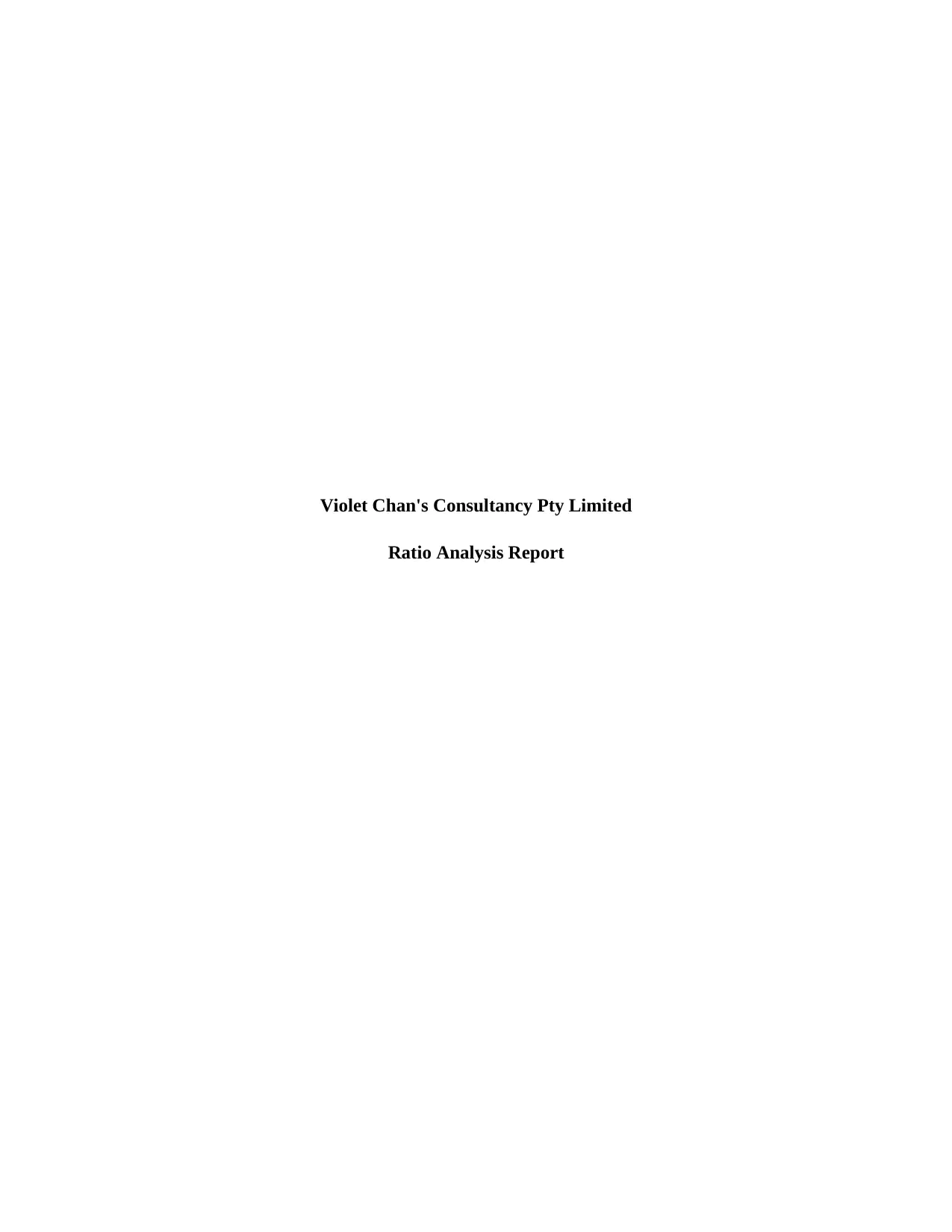
Violet Chan's Consultancy Pty Limited
Ratio Analysis Report
Ratio Analysis Report
Paraphrase This Document
Need a fresh take? Get an instant paraphrase of this document with our AI Paraphraser
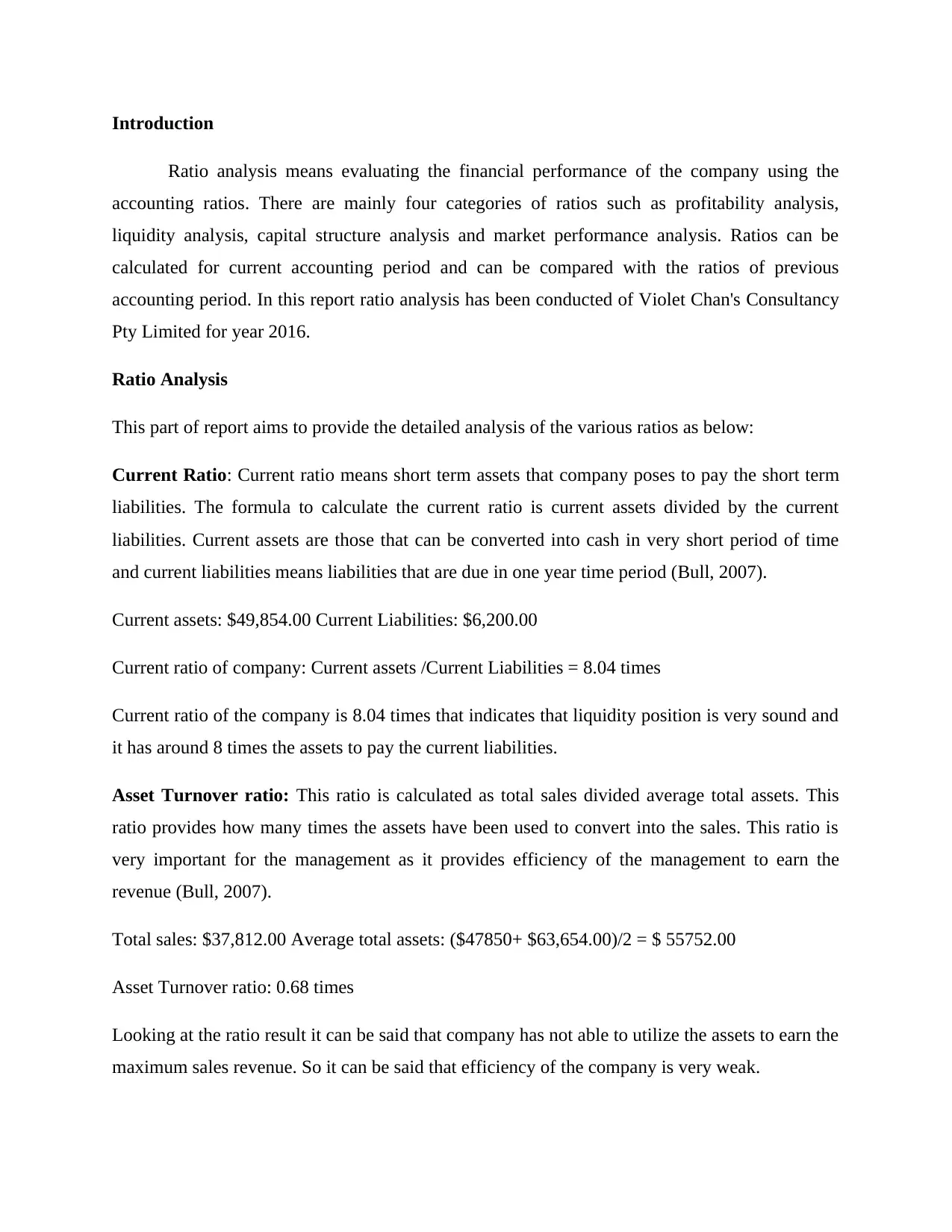
Introduction
Ratio analysis means evaluating the financial performance of the company using the
accounting ratios. There are mainly four categories of ratios such as profitability analysis,
liquidity analysis, capital structure analysis and market performance analysis. Ratios can be
calculated for current accounting period and can be compared with the ratios of previous
accounting period. In this report ratio analysis has been conducted of Violet Chan's Consultancy
Pty Limited for year 2016.
Ratio Analysis
This part of report aims to provide the detailed analysis of the various ratios as below:
Current Ratio: Current ratio means short term assets that company poses to pay the short term
liabilities. The formula to calculate the current ratio is current assets divided by the current
liabilities. Current assets are those that can be converted into cash in very short period of time
and current liabilities means liabilities that are due in one year time period (Bull, 2007).
Current assets: $49,854.00 Current Liabilities: $6,200.00
Current ratio of company: Current assets /Current Liabilities = 8.04 times
Current ratio of the company is 8.04 times that indicates that liquidity position is very sound and
it has around 8 times the assets to pay the current liabilities.
Asset Turnover ratio: This ratio is calculated as total sales divided average total assets. This
ratio provides how many times the assets have been used to convert into the sales. This ratio is
very important for the management as it provides efficiency of the management to earn the
revenue (Bull, 2007).
Total sales: $37,812.00 Average total assets: ($47850+ $63,654.00)/2 = $ 55752.00
Asset Turnover ratio: 0.68 times
Looking at the ratio result it can be said that company has not able to utilize the assets to earn the
maximum sales revenue. So it can be said that efficiency of the company is very weak.
Ratio analysis means evaluating the financial performance of the company using the
accounting ratios. There are mainly four categories of ratios such as profitability analysis,
liquidity analysis, capital structure analysis and market performance analysis. Ratios can be
calculated for current accounting period and can be compared with the ratios of previous
accounting period. In this report ratio analysis has been conducted of Violet Chan's Consultancy
Pty Limited for year 2016.
Ratio Analysis
This part of report aims to provide the detailed analysis of the various ratios as below:
Current Ratio: Current ratio means short term assets that company poses to pay the short term
liabilities. The formula to calculate the current ratio is current assets divided by the current
liabilities. Current assets are those that can be converted into cash in very short period of time
and current liabilities means liabilities that are due in one year time period (Bull, 2007).
Current assets: $49,854.00 Current Liabilities: $6,200.00
Current ratio of company: Current assets /Current Liabilities = 8.04 times
Current ratio of the company is 8.04 times that indicates that liquidity position is very sound and
it has around 8 times the assets to pay the current liabilities.
Asset Turnover ratio: This ratio is calculated as total sales divided average total assets. This
ratio provides how many times the assets have been used to convert into the sales. This ratio is
very important for the management as it provides efficiency of the management to earn the
revenue (Bull, 2007).
Total sales: $37,812.00 Average total assets: ($47850+ $63,654.00)/2 = $ 55752.00
Asset Turnover ratio: 0.68 times
Looking at the ratio result it can be said that company has not able to utilize the assets to earn the
maximum sales revenue. So it can be said that efficiency of the company is very weak.
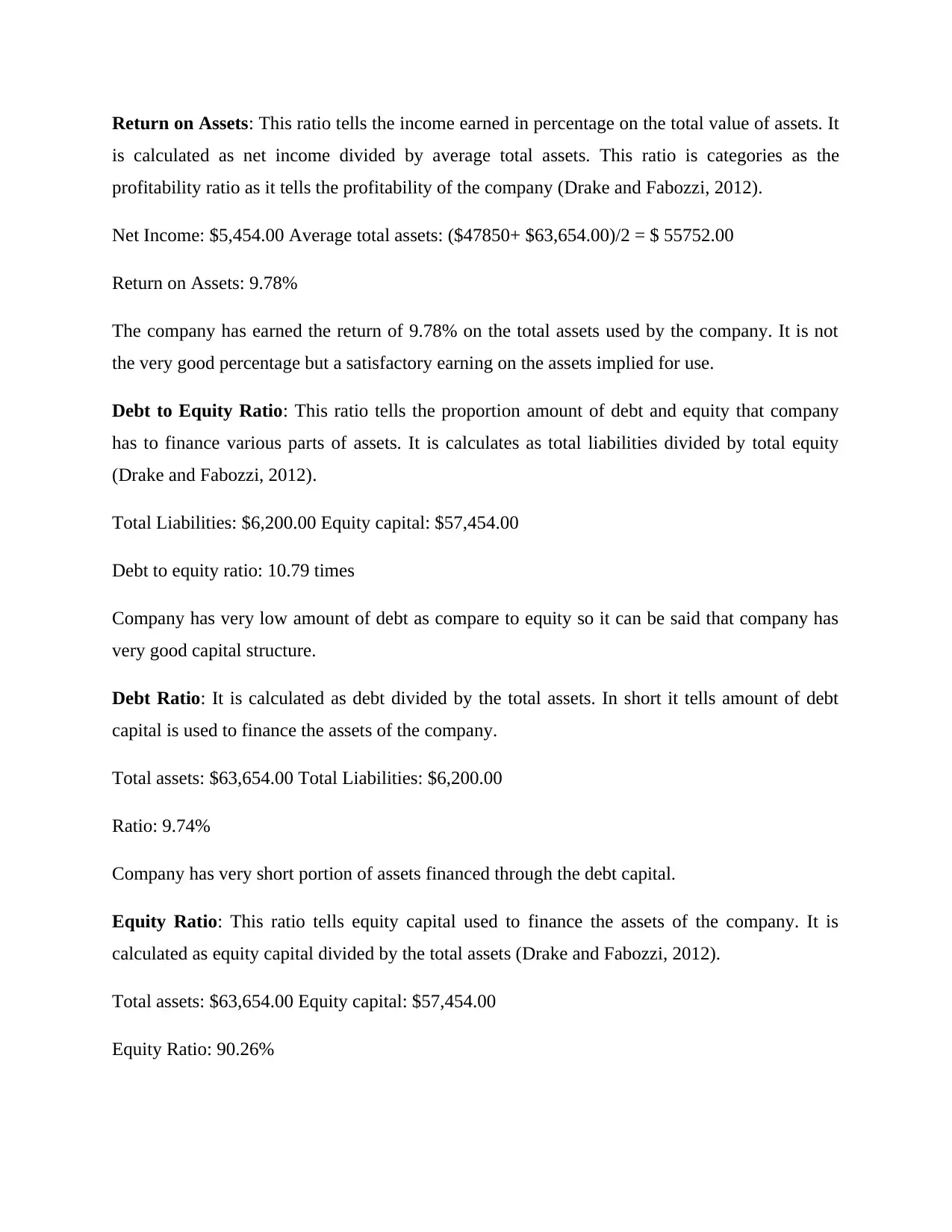
Return on Assets: This ratio tells the income earned in percentage on the total value of assets. It
is calculated as net income divided by average total assets. This ratio is categories as the
profitability ratio as it tells the profitability of the company (Drake and Fabozzi, 2012).
Net Income: $5,454.00 Average total assets: ($47850+ $63,654.00)/2 = $ 55752.00
Return on Assets: 9.78%
The company has earned the return of 9.78% on the total assets used by the company. It is not
the very good percentage but a satisfactory earning on the assets implied for use.
Debt to Equity Ratio: This ratio tells the proportion amount of debt and equity that company
has to finance various parts of assets. It is calculates as total liabilities divided by total equity
(Drake and Fabozzi, 2012).
Total Liabilities: $6,200.00 Equity capital: $57,454.00
Debt to equity ratio: 10.79 times
Company has very low amount of debt as compare to equity so it can be said that company has
very good capital structure.
Debt Ratio: It is calculated as debt divided by the total assets. In short it tells amount of debt
capital is used to finance the assets of the company.
Total assets: $63,654.00 Total Liabilities: $6,200.00
Ratio: 9.74%
Company has very short portion of assets financed through the debt capital.
Equity Ratio: This ratio tells equity capital used to finance the assets of the company. It is
calculated as equity capital divided by the total assets (Drake and Fabozzi, 2012).
Total assets: $63,654.00 Equity capital: $57,454.00
Equity Ratio: 90.26%
is calculated as net income divided by average total assets. This ratio is categories as the
profitability ratio as it tells the profitability of the company (Drake and Fabozzi, 2012).
Net Income: $5,454.00 Average total assets: ($47850+ $63,654.00)/2 = $ 55752.00
Return on Assets: 9.78%
The company has earned the return of 9.78% on the total assets used by the company. It is not
the very good percentage but a satisfactory earning on the assets implied for use.
Debt to Equity Ratio: This ratio tells the proportion amount of debt and equity that company
has to finance various parts of assets. It is calculates as total liabilities divided by total equity
(Drake and Fabozzi, 2012).
Total Liabilities: $6,200.00 Equity capital: $57,454.00
Debt to equity ratio: 10.79 times
Company has very low amount of debt as compare to equity so it can be said that company has
very good capital structure.
Debt Ratio: It is calculated as debt divided by the total assets. In short it tells amount of debt
capital is used to finance the assets of the company.
Total assets: $63,654.00 Total Liabilities: $6,200.00
Ratio: 9.74%
Company has very short portion of assets financed through the debt capital.
Equity Ratio: This ratio tells equity capital used to finance the assets of the company. It is
calculated as equity capital divided by the total assets (Drake and Fabozzi, 2012).
Total assets: $63,654.00 Equity capital: $57,454.00
Equity Ratio: 90.26%
⊘ This is a preview!⊘
Do you want full access?
Subscribe today to unlock all pages.

Trusted by 1+ million students worldwide
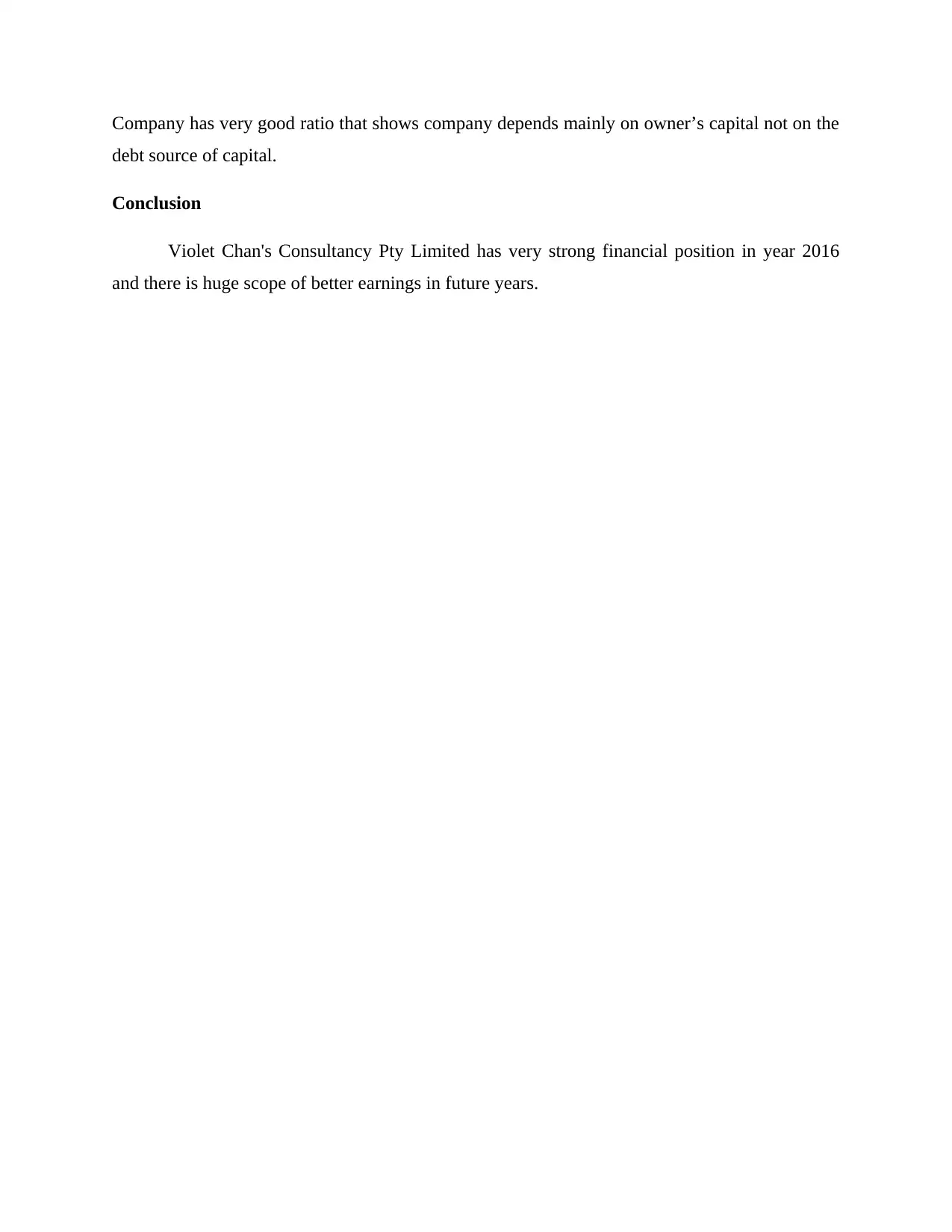
Company has very good ratio that shows company depends mainly on owner’s capital not on the
debt source of capital.
Conclusion
Violet Chan's Consultancy Pty Limited has very strong financial position in year 2016
and there is huge scope of better earnings in future years.
debt source of capital.
Conclusion
Violet Chan's Consultancy Pty Limited has very strong financial position in year 2016
and there is huge scope of better earnings in future years.
Paraphrase This Document
Need a fresh take? Get an instant paraphrase of this document with our AI Paraphraser
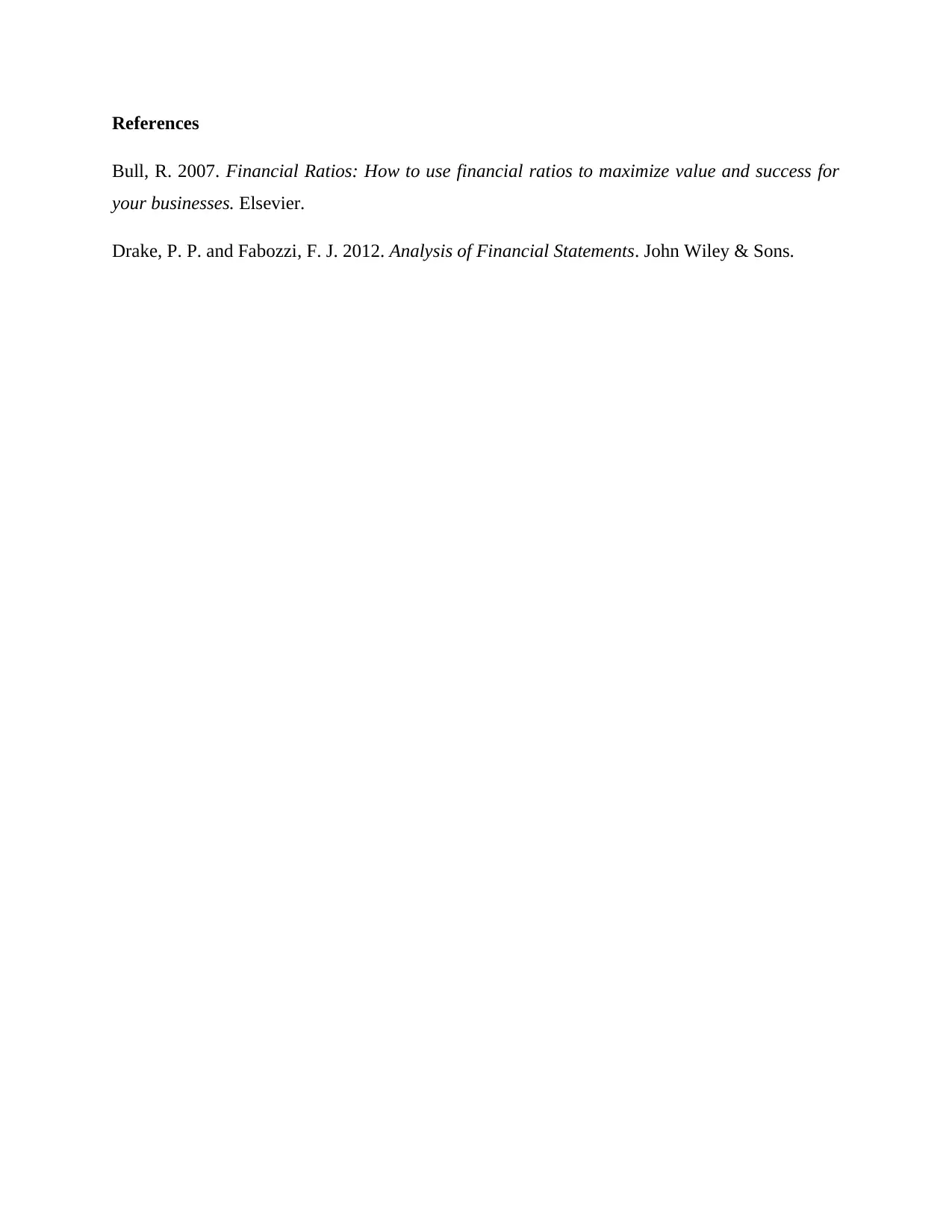
References
Bull, R. 2007. Financial Ratios: How to use financial ratios to maximize value and success for
your businesses. Elsevier.
Drake, P. P. and Fabozzi, F. J. 2012. Analysis of Financial Statements. John Wiley & Sons.
Bull, R. 2007. Financial Ratios: How to use financial ratios to maximize value and success for
your businesses. Elsevier.
Drake, P. P. and Fabozzi, F. J. 2012. Analysis of Financial Statements. John Wiley & Sons.
1 out of 5
Related Documents
Your All-in-One AI-Powered Toolkit for Academic Success.
+13062052269
info@desklib.com
Available 24*7 on WhatsApp / Email
![[object Object]](/_next/static/media/star-bottom.7253800d.svg)
Unlock your academic potential
Copyright © 2020–2025 A2Z Services. All Rights Reserved. Developed and managed by ZUCOL.




